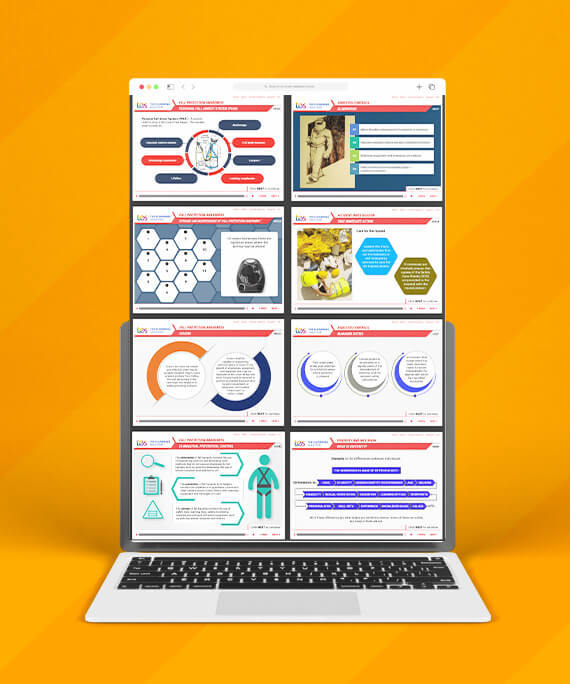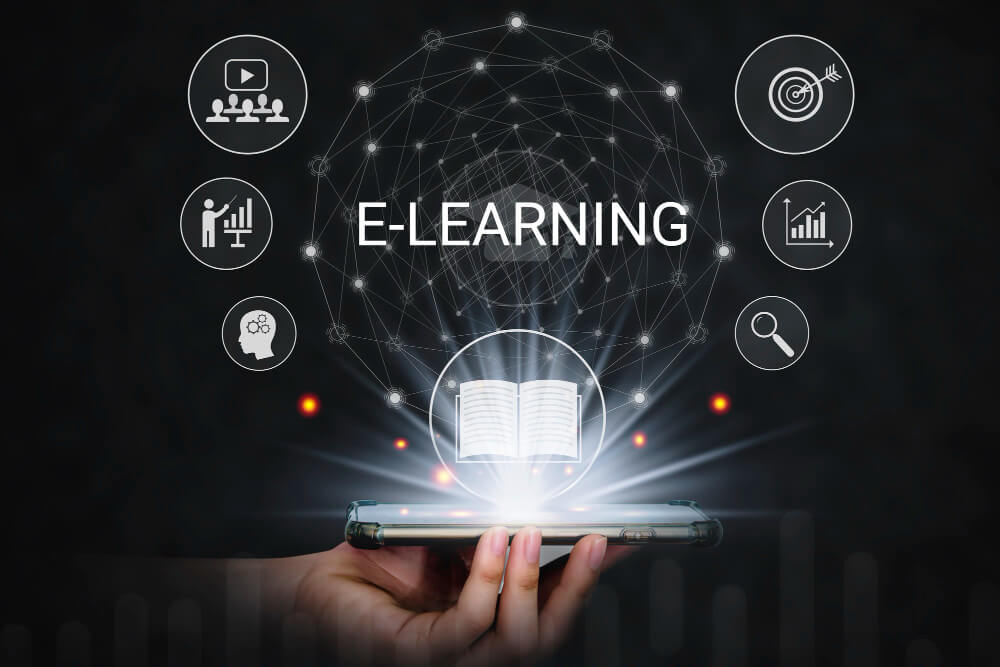Convert PowerPoint Presentations Into eLearning Courses
Transform Your PowerPoint into Engaging eLearning Courses!
Welcome to the eLearning solution that bridges the gap between static presentations and dynamic eLearning experiences. Our expert team specializes in converting your current PowerPoint-based content into captivating HTML5 SCORM-compliant eLearning courses.





Why you should convert your classroom training into online learning courses.
Converting your classroom-based courses to eLearning can offer numerous benefits, enhancing the learning experience for both educators and learners. This transition leverages technology to create a flexible and accessible learning environment that can cater to a wider range of learners’ needs. Here are some compelling reasons why you should consider converting your classroom to eLearning courses:
Flexibility and Accessibility
Cost-Efficiency
Scalability
Engagement and Interactivity
Data-Driven Insights
Personalization


PPT to eLearning Conversion?
Share Your Content
Based on your requirements for converting PowerPoint to eLearning content, we will provide you with appropriate samples, case studies, and estimates to examine.


Get A FREE Prototype
After our conversation, we will create a prototype at no cost that aligns with your specifications. This prototype aims to provide you with insight into our work approach and quality of work.
Ready To Go Live
Upon prototype approval, our course planning will commence, followed by course development, quality checks, and finally, the delivery of the ultimate source and publish files.






PPT to eLearning Conversion?

Training Industry Experts
We're a team of experts – learning designers, developers, and project managers. Together, we make tailored training for different industries. Our courses fit your needs perfectly.

Cost-Effective & Time Saving
Besides saving you money and time, we prioritize top-notch quality. We've set up clear steps and a dedicated team to make sure everything meets high standards.

Bringing Learning to the World
We provide eLearning to different places and industries globally. Our services bring benefits like saving money, time, and ensuring great quality.
eLearning Case Studies


Frequently Asked Questions
What is the process of converting PowerPoint into eLearning content?
Converting PowerPoint presentations into engaging eLearning content involves a series of steps that help transform static slides into interactive and effective learning materials. Here's a breakdown of the process:
- Content Analysis:
- Review the PowerPoint presentation to understand its structure, content, and learning objectives.
- Identify key elements that can be transformed into interactive elements, such as quizzes, activities, and multimedia.
- Storyboarding:
- Create a storyboard that outlines the flow of the eLearning module, including navigation, interactions, and assessments.
- Define the sequence of slides, interactive elements, and the overall user experience.
- Content Enhancement:
- Revise and enhance the content for eLearning format, ensuring it's concise, clear, and suitable for self-paced learning.
- Break down complex concepts into bite-sized modules for better comprehension.
- Interactive Elements:
- Integrate interactive features like click-through animations, drag-and-drop interactions, and clickable buttons.
- Embed multimedia elements such as videos, audio, and simulations to enhance engagement.
- Assessments and Quizzes:
- Develop knowledge checks, quizzes, and assessments to reinforce learning and measure understanding.
- Use various question types like multiple-choice, true/false, and matching to cater to different learning styles.
- Visual Design:
- Customize the eLearning content's visual design to align with your branding and create an appealing, consistent look.
- Ensure the text, images, and colors enhance readability and visual appeal.
- Navigation and Interactivity:
- Implement intuitive navigation controls that allow learners to move through the content seamlessly.
- Add interactive elements that encourage active participation, such as clickable tabs and branching scenarios.
- Responsive Design:
- Optimize the eLearning content for various devices and screen sizes to ensure a consistent experience on desktops, tablets, and smartphones.
- User Testing:
- Conduct thorough testing to identify any technical glitches, broken links, or usability issues.
- Invite a diverse group of users to provide feedback on the content's clarity and effectiveness.
- Review and Revisions:
- Review the entire eLearning module to ensure it aligns with the learning objectives and meets the desired outcomes.
- Make necessary revisions based on feedback and testing results.
- Publishing:
- Export the eLearning content in a compatible format, such as SCORM or xAPI, depending on your learning management system (LMS) requirements.
- Upload the content to your LMS and ensure proper integration with tracking and reporting features.
- Continuous Improvement:
- Monitor learner engagement and performance through the LMS analytics.
- Gather feedback from learners and instructors to make iterative improvements to the eLearning content.
Converting PowerPoint into eLearning content requires careful planning, creativity, and attention to detail to create a rich and interactive learning experience for your audience.
What is the typical turnaround time for converting PowerPoint to eLearning content?
The duration required to convert a PowerPoint presentation into fully-fledged eLearning content can vary based on several factors. While there is no one-size-fits-all answer, understanding these factors can provide a general idea of the typical turnaround time:
Content Complexity: The complexity of the PowerPoint presentation itself plays a significant role. If the presentation contains intricate animations, multimedia elements, and interactive components, the conversion process may take longer.
Interactivity Level: The extent of interactivity you aim to achieve in the eLearning content impacts the time required. Basic conversions with minimal interactive elements may be quicker than those requiring complex branching scenarios and simulations.
Length of Presentation: The number of slides and the overall length of the presentation influence the conversion time. Longer presentations naturally require more time for content enhancement, interactivity, and testing.
Design and Visuals: If the PowerPoint slides have a simple design that translates well to the eLearning format, the conversion process might be expedited. However, if significant design modifications are needed for an engaging eLearning experience, additional time will be necessary.
Assessment Complexity: If the eLearning content includes assessments, creating and testing the quizzes or knowledge checks will extend the turnaround time.
Review and Revisions: The time needed for reviewing and incorporating feedback from stakeholders, subject matter experts, and user testing can impact the overall duration.
As a rough estimate, a straightforward conversion of a moderately sized PowerPoint presentation (around 20-30 slides) into basic eLearning content might take approximately 2-3 weeks. However, more complex projects with extensive interactivity, multimedia integration, and assessments could take 4-6 weeks or more.
It's important to note that each project is unique, and collaboration between instructional designers, content developers, graphic designers, and other stakeholders can influence the timeline. Clear communication, a well-defined project scope, and a realistic assessment of the project's requirements are crucial for determining an accurate turnaround time.
What is the cost range for converting PowerPoint presentations into eLearning modules?
The cost of converting PowerPoint presentations into eLearning modules can vary widely based on a multitude of factors. Here are the key considerations that contribute to the cost range:
Content Complexity: The complexity of the PowerPoint content itself greatly influences the cost. Presentations with intricate animations, complex visuals, and detailed text might require more effort to translate into interactive eLearning content.
Interactivity Level: The extent of interactivity you want to include in the eLearning modules impacts the cost. Basic conversions with minimal interactions will generally be less expensive than those requiring custom simulations, branching scenarios, and gamified elements.
Visual Design: If the PowerPoint presentation's design doesn't translate well to an eLearning format, additional design work will be needed, potentially increasing the cost. Custom graphics, animations, and visual enhancements contribute to the overall expense.
Multimedia Integration: Adding videos, audio, and other multimedia elements to enhance the learning experience can increase the cost, especially if these elements need to be created or edited.
Assessment Complexity: If the eLearning modules include assessments or quizzes, the complexity and number of questions will impact the cost. Developing and testing assessments can require additional resources.
Number of Slides: The total number of slides in the PowerPoint presentation directly affects the cost. More slides typically mean more time spent on content conversion and integration.
Customization and Branding: If you require a high level of customization to align the eLearning content with your branding and specific requirements, the cost may increase due to the additional design and development work.
Technology Requirements: The choice of technology and tools for building the eLearning modules can impact the cost. Some platforms and authoring tools have associated licensing fees.
As a rough estimate, a basic conversion of a small to moderately sized PowerPoint presentation into eLearning content might start at a few thousand dollars. However, more complex projects with extensive interactivity, multimedia elements, and custom design could range from several thousand to tens of thousands of dollars.
It's important to work closely with eLearning development professionals or agencies to get accurate cost estimates tailored to your project's specific needs. A well-defined project scope, clear communication about requirements, and a realistic budget allocation are key to ensuring a successful and cost-effective conversion process.
What types of interactivity can be added during the conversion process?
During the conversion process from PowerPoint presentations to eLearning modules, various types of interactivity can be integrated to enhance learner engagement and promote active participation. Here are some key options:
Clickable Elements: Transform static elements on slides into clickable buttons or tabs that reveal additional information, pop-up explanations, or access related resources.
Animations: Add click-through animations that allow learners to progress step-by-step, controlling the pace of their learning and providing visual engagement.
Interactive Quizzes: Incorporate quizzes with different question types (multiple-choice, true/false, matching, etc.) to assess knowledge and reinforce learning.
Drag-and-Drop Activities: Create interactive exercises where learners drag items to their correct locations, enhancing understanding through hands-on manipulation.
Branching Scenarios: Develop scenarios where learners make decisions, leading to different paths and outcomes, allowing them to see the consequences of their choices.
Simulations: Include realistic simulations that replicate real-world situations, enabling learners to practice skills and decision-making in a safe environment.
Clickable Hotspots: Design images with clickable hotspots that provide additional information or context when learners interact with specific areas.
Video and Audio: Integrate videos and audio clips to explain complex concepts, provide real-life examples, or enhance engagement through different sensory modalities.
Gamification Elements: Add gamified elements like points, badges, leaderboards, and challenges to motivate learners and make the learning experience more enjoyable.
Progress Tracking: Implement progress indicators, completion bars, and checkpoints to help learners track their advancement through the module.
Interactive Assessments: Design assessments where learners actively engage with content, such as categorizing items, sequencing steps, or analyzing data.
Collaborative Activities: Include group discussions, collaborative projects, and forums that encourage learners to share ideas and learn from each other.
Clickable Pathways: Create interactive pathways that allow learners to choose their learning journey, catering to different interests or knowledge levels.
Reflection and Journaling: Provide spaces for learners to reflect on their learning, write journal entries, or set goals, fostering a deeper understanding.
Interactive Infographics: Transform static information into interactive infographics that allow learners to explore data, trends, and relationships.
Navigation Choices: Offer non-linear navigation options, allowing learners to explore topics in the order that best suits their learning preferences.
Feedback Mechanisms: Provide immediate feedback for quizzes, activities, and assessments to help learners understand their strengths and areas for improvement.
Social Sharing: Integrate sharing options that allow learners to share their progress, achievements, or insights on social media platforms.
By selecting and combining these interactive elements thoughtfully, the conversion process can create engaging and effective eLearning modules that cater to various learning styles and objectives.
How can I ensure the eLearning content is compatible with different devices and platforms?
In today's diverse learning landscape, it's crucial to make sure that your eLearning content is accessible and functional across various devices and platforms. Achieving compatibility requires a combination of design considerations, technical choices, and testing processes. Here's how to ensure your eLearning content reaches learners regardless of their device or platform:
Responsive Design: Adopt a responsive design approach that automatically adjusts the layout and formatting of your eLearning content based on the screen size of the device being used. This ensures optimal viewing and interaction experiences across desktops, tablets, and smartphones.
Mobile-First Design: Start the design process with mobile devices in mind. Creating a layout that works well on small screens ensures a strong foundation for scalability to larger screens.
Use Standards-Compliant Technology: Utilize web technologies that are widely supported and adhere to industry standards. HTML5, CSS3, and JavaScript are common choices that offer broad compatibility.
Select Compatible Authoring Tools: Choose eLearning authoring tools that generate content compatible with multiple devices and platforms. Many modern authoring tools are designed to create responsive content that works seamlessly on different devices.
Cross-Browser Testing: Test your eLearning content on various web browsers (Chrome, Firefox, Safari, Edge, etc.) to ensure that it functions correctly and looks consistent across different browser environments.
Cross-Device Testing: Test your eLearning content on different types of devices (smartphones, tablets, laptops, etc.) to identify any display or functionality issues specific to certain devices.
Operating System Compatibility: Check compatibility with different operating systems (Windows, macOS, iOS, Android, etc.) to ensure that the content performs well across various environments.
Performance Optimization: Optimize media files (images, videos, audio) to ensure fast loading times and smooth playback, even on devices with slower internet connections or less processing power.
User Interface Consistency: Maintain a consistent user interface and navigation across all devices to provide a familiar and intuitive experience for learners.
Touch-Friendly Interactions: Design interactive elements that work well with touch gestures, especially for mobile devices. Buttons and clickable areas should be appropriately sized for touch inputs.
Usability Testing: Conduct thorough usability testing across different devices and platforms. Involve a diverse group of users to identify any issues related to navigation, interactivity, or performance.
Accessibility Considerations: Ensure your eLearning content is accessible to individuals with disabilities by adhering to accessibility standards (such as WCAG) and testing with assistive technologies.
Regular Updates: As technology evolves, continue to monitor and update your eLearning content to ensure ongoing compatibility with new devices, browsers, and platforms.
LMS Compatibility: Verify that your eLearning content integrates seamlessly with your chosen Learning Management System (LMS) and that tracking, reporting, and user data functions properly.
By implementing these strategies, you can create eLearning content that provides a consistent and engaging learning experience for learners, regardless of the devices and platforms they use.
Can assessments and quizzes be integrated into converted eLearning content?
Absolutely, assessments and quizzes can be seamlessly integrated into eLearning content that has been converted from PowerPoint presentations. Including assessments not only helps reinforce learning but also provides a means to measure learners' understanding and progress. Here's how you can incorporate assessments and quizzes into your converted eLearning modules:
Assessment Relevance: Determine the learning objectives and goals of your eLearning module. Based on these objectives, decide what types of assessments – such as knowledge checks, quizzes, or end-of-module tests – are appropriate to evaluate learner comprehension.
Question Types: Choose a variety of question types to cater to different learning styles and encourage deeper understanding. Common question types include multiple-choice, true/false, matching, fill-in-the-blank, and open-ended questions.
Assessment Placement: Integrate assessments at strategic points within the eLearning module. This could be at the end of each section or at the conclusion of the entire module. The placement should align with the learning flow.
Interactive Format: Convert traditional text-based questions into interactive formats. Incorporate clickable elements, drag-and-drop activities, and multimedia to make assessments engaging and challenging.
Feedback Mechanisms: Provide immediate feedback after each question, indicating whether the response was correct or incorrect. For incorrect answers, offer explanations to help learners understand the concept better.
Progress Tracking: Implement progress tracking features that allow learners to see their advancement through the assessments. This motivates learners and provides a sense of accomplishment.
Scoring and Reporting: Develop a scoring system for assessments, assigning points or scores based on correctness. Ensure that the assessment results are accurately recorded and can be integrated with your Learning Management System (LMS) for tracking and reporting.
Adaptive Assessments: Consider creating adaptive assessments that adjust the difficulty level of questions based on learners' performance. This personalizes the learning experience and challenges learners appropriately.
Timed Assessments: Optionally, you can introduce time limits for assessments, simulating real-world scenarios where quick decision-making is crucial.
Scenario-Based Assessments: For more advanced eLearning content, incorporate scenario-based assessments that require learners to apply their knowledge to realistic situations.
Gamified Assessments: Gamification elements like points, rewards, and leaderboards can be integrated into assessments to increase engagement and motivation.
User Testing: Before finalizing assessments, conduct user testing to ensure that the questions are clear, the interactions work as intended, and there are no technical glitches.
Integrating assessments and quizzes adds a layer of interactivity and evaluation to your eLearning content. Careful design and consideration of assessment strategies contribute to a comprehensive and effective learning experience for your audience.

“The level of support we received was outstanding. They were responsive, proactive, and went above and beyond to ensure our project’s success. Their expertise in eLearning development is unparalleled, and we look forward to continuing our collaboration with them.”

John Paul
General Manager


Clients Feedback
We take pride in delivering exceptional eLearning solutions that exceed our clients’ expectations. Don’t just take our word for it, here’s what our satisfied clients had to say.
People Love To Learn With Us
100%
Learners Complete Course Successfully
10/10
Users reported better learning outcomes.
Create the eLearning modules.
eLearning Blogs / News
A Complete Guide on Instructional Design
- 17 Aug, 2023
- 0 Cmnts
Hire an eLearning Course Developer / eLearning Specialist
- 16 Aug, 2023
- 0 Cmnts
Convert Text-based Training Material into eLearning Module
- 16 Aug, 2023
- 0 Cmnts
Learning Management Systems for Employee Training
- 16 Aug, 2023
- 0 Cmnts





















